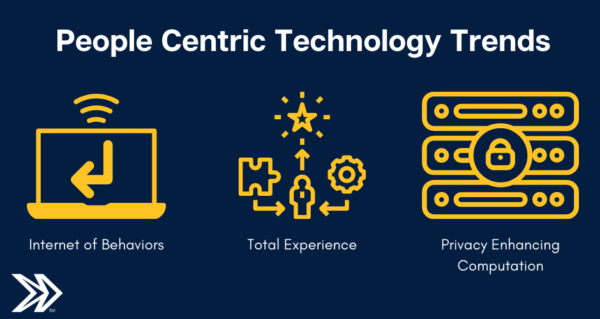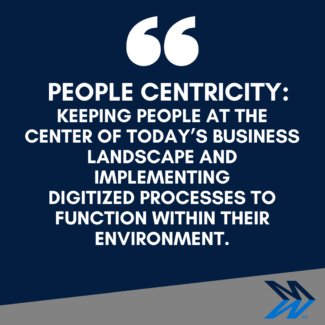October 27, 2020
By: Kim Morgan
Each year, research firm Gartner unveils the top strategic technology trends at its annual IT Symposium/Xpo America’s conference. This year was no different, except the conference was held virtually instead of in-person.
Indeed, a virtual symposium is probably the most “2020” thing right now. Gartner underscored how companies need to focus on building resilience and adapting to unavoidable disruptions. “The need for operational resiliency across enterprise functions has never been greater,” said Brian Burke, research vice president at Gartner.
“As organizations journey from responding to the COVID-19 crisis to driving growth, they must focus on the three main areas that form the themes of this year’s trends: people centricity, location independence and resilient delivery,” Burke said.
With the idea of adapting to disruption in mind, Gartner centered their trends around three themes:
- People centricity: keeping people at the center of today’s business landscape and implementing digitized processes to function within their environment.
- Location independence: COVID-19 dramatically shifted the physical locations of customers, employees, suppliers, and entire organizational ecosystems. Location independence is crucial for businesses to function and succeed in a “together but apart” society.
- Resilient delivery: recognizing that volatility exists in the world and calling upon the ability to pivot or adapt in the face of volatility.
It is important to note, however, that these three categories do exist independently of one another, but instead “build and reinforce” each other. As Gartner puts it “Together they enable organizational plasticity that will help guide organizations in the next five years.”
In this first part of a three-part series, we will look at “People Centricity” is shaping the future of technology, and how businesses will employ that change.
People Centricity
 Internet of Behaviors
Internet of Behaviors
The Internet of Behaviors (IoB) what Gartner calls the “digital dust” that is “left behind” by people from a variety of sources. This data is then used by public or private entities to influence the behavior of that person. Common sources of this data are social media, commercial customer data, and even facial recognition.
Imagine you are soft remodeling a bathroom. First, you ask your Facebook friends for a handyman that can replace a toilet, then you search Pinterest for space-saving ideas, and finally you visit a few eCommerce sites and search for a new light fixture and cabinet pulls. Individually, the parts of your behavior can provide a rough estimate for what you may be doing, but the IoB takes the sum of your actions and determines that indeed, this is a bathroom remodel, and paves the way for targeted ads for bathroom accessories, and even beauty products.
As one can imagine, this poses massive ethical and social implications. According to Gartner, Collecting data to influence behaviors has the potential to be a powerful tool, and its social reception might
depend on just how heavy-handed organizations are with what they’re trying to do.” As digital privacy laws are being put into effect across the globe, collectors of data need to incentivize consumers to hand over their info, so to speak. At the end of the day, the IoB must offer a mutual benefit to both parties – like lowered insurance premiums for drivers that share driving data or discounts on household items for shoppers who share spending habits.
Total Experience
Lately, everything is an “X”. Customer experience (CX), user experience (UX), patient experience (PX), employee experience (EX). Total Experience is just that, the sum of all the “X’s” in the universe. This practice aims to streamline a consumer’s experience with a brand across all platforms and channels and serves as a differentiator against competitors.
COVID-19 taught businesses the true power of total experience. Brick and mortar stores could no longer rely on foot traffic, or “window shoppers” to generate revenue, so they deployed systems to not only bring products to consumers, but also keep both consumers safe through the use of smartphone apps or geo-triggered events. This insulated experience not only keeps the shopper within the company but delivers a seamless shopping experience. Just like frictionless experiences with contact centers, in-person activities are elevated through the use of AI and other tech.

Privacy-enhancing Computation
Privacy-enhancing computation involves three types of technologies that protect data while that data is in use. This enables secure data processing and more reliable analytics.
- A trusted environment in which sensitive data can be processed or analyzed. This includes trusted third parties and confidential computing (hardware-trusted execution environments).
- Processing and analytics in a decentralized manner. This includes federated machine learning and privacy-aware machine learning.
- Transforming data and algorithms before processing or analytics. This practice includes differential privacy, homomorphic encryption, secure multiparty computation, zero-knowledge proofs, private set intersection and private information retrieval.
Say what now? How is this practice “people-centric” when it involves complex computing? The three above processes ensure that data is secure and anonymous, but still accurate. Again, lessons from COVID-19 included reliance on devices for communicating with family and friends, shopping for basic necessities, learning from levels as low as PreK and as high as post-doctoral studies, and workers across all organizations shifting from in-office to at-home. In this massive flow of data, there are bound to be breaches. Businesses that can boast a more secure experience will have the upper hand when it comes to garnering new business, and ultimately gaining the trust of their customers.
Stay tuned for part two of this series which focuses on “Location Independence”. Learn, why businesses and organizations can, and should, leverage the power of the cloud to connect with employees, customers, and each other.
About Mindsight
Mindsight is industry recognized for delivering secure IT solutions and thought leadership that address your infrastructure and communications needs. Our engineers are expert level only – and they’re known as the most respected and valued engineering team based in Chicago, serving emerging to enterprise organizations around the globe. That’s why clients trust Mindsight as an extension of their IT team.
Visit us at http://www.gomindsight.com.
About the Author
Kim Morgan is part of the Marketing Department at Mindsight. Since 2007, she has devoted her career to using digital media to educate and effectively communicate a variety of topics at all levels of expertise. Kim’s favorite part about Mindsight is how team members are encouraged to always be curious, and continue developing not only professionally, but also personally. When not working, she can be found toting her 4 kids around in her sweet sweet minivan while rocking out to hits from the late 90’s and early 2000’s.
 Internet of Behaviors
Internet of Behaviors 